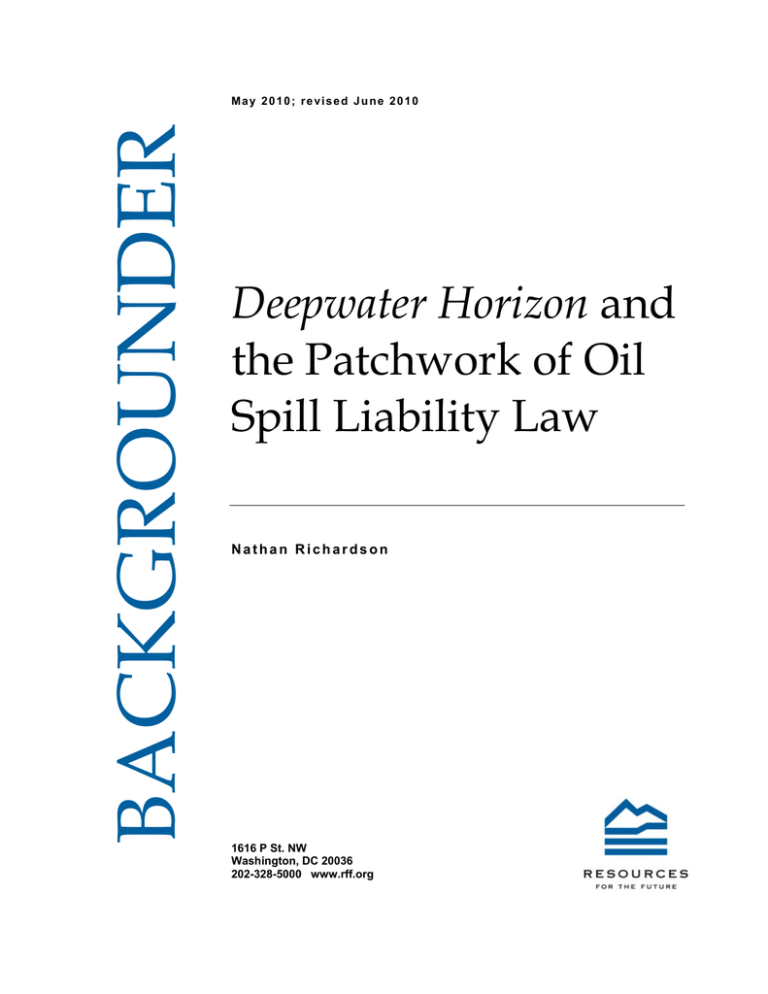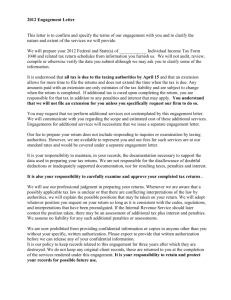BACKGROUNDER Deepwater Horizon the Patchwork of Oil
advertisement

BACKGROUNDER M a y 2 0 1 0 ; r e vi s e d J u n e 2 0 1 0 Deepwater Horizon and the Patchwork of Oil Spill Liability Law Nathan Richardson 1616 P St. NW Washington, DC 20036 202-328-5000 www.rff.org Resources for the Future Richardson Deepwater Horizon and the Patchwork of Oil Spill Liability Law Nathan Richardson∗ Introduction An oil rig explodes in the Gulf of Mexico, with tragic results. Millions of barrels of oil leak into the water. Cleanup costs are massive—but could pale in comparison to the costs of damages to natural resources, private property, and livelihoods. Who will pay these costs? How much will be covered by the petroleum company (or its subcontractors) and how much will fall to the public at large (or go completely uncompensated)? All these issues will be the subject of major litigation. Counsel for BP and other involved firms, federal and state prosecutors, and private plaintiffs’ lawyers will undoubtedly spend many years in court and at the negotiating table. Predicting the specific results of this process is impossible. But the process will be governed by an identifiable background of laws. Understanding these laws is a necessary first step to predicting how (and whether) adequate compensation for damages will be made—and not just for major disasters like Deepwater Horizon, but for the many smaller spills that happen much more frequently. The law of oil spill liability is a patchwork, built from relatively ancient traditions of maritime law but with a major overlay of modern statutes. It is a mixture of civil liability (at both the federal and state level) and criminal regimes. Different claimants with varying types of damage claims are treated differently. While liability is the primary method of preventing spills, significant regulations exist as well, and these regulations influence the liability rules in turn. This complexity is the result of an uneasy compromise between industry interests and legislators motivated by damages from spills. Historically, this compromise has shifted in response to major spills, and is likely to do so again in the wake of the Deepwater Horizon spill. ∗ Nathan Richardson is a visiting scholar at Resources for the future; richardson@rff.org. © 2010. Resources for the Future. All rights reserved. No portion of this paper may be reproduced without permission of the authors. 1 Resources for the Future Richardson Core Principles of Oil Spill Liability Three principles are at the heart of the law governing oil spill liability: strict liability, “channeling” of liability, and liability limits. All three have long traditions, but are firmly established by the primary American statute governing liability for oil spills, the Oil Pollution Act of 1990 (OPA 90)—a law enacted largely in response to the last major oil spill, from the Exxon Valdez. It’s worth discussing each concept briefly in turn. Strict Liability OPA 90 makes parties responsible for oil spills strictly liable for damages caused. The principle of strict liability is likely familiar and relatively easy to understand. If a party is strictly liable, it is not necessary to show that party acted negligently for liability to attach. The advantage of strict liability is that (as compared to a negligence standard) it simplifies litigation and may lead to more efficient activity levels.1 Strict liability makes sense where, as with oil spills, precautions can best be taken by one of the parties (and where large numbers of thirdparty victims make bargains between the parties difficult or impossible). We can be relatively sure that oil producers or transporters, not spill victims, are the lowest-cost-avoiders of spill damages. Channeling OPA 90 also “channels” liability for oil spills by specifying exactly who is to be treated as the responsible party for liability purposes. For spills from vessels, the owner/operator of the vessel is the responsible party. For offshore facilities like Deepwater Horizon, the holder of the drilling permit (in this case, BP) is the responsible party. Like strict liability, channeling of liability simplifies litigation—it isn’t necessary for courts to determine which party caused the spill. Fights over causation will still happen, but in the context of contribution actions—suits by the responsible party to recover from other parties for damages paid. Liability Limits The most controversial aspect of oil spill liability law is caps on the liability of parties responsible for spills. Liability caps are traditional in maritime law, but the wisdom of applying 1 But note that, somewhat counterintuitively, strict liability will not generally result in the responsible party taking any additional precautions beyond those they would take under a negligence regime. 2 Resources for the Future Richardson them to oil spills and other events that damage third parties is debated. OPA 90 includes liability caps that vary depending on the type of spill and type of damage caused. For offshore facilities like Deepwater Horizon, damages are capped at $75 million. This cap applies to both major classes of damage from oil spills: natural resource damages and economic damages to private parties. Only direct cleanup costs are exempt from the cap. While these limits in OPA 90 are controversial, especially in the wake of a large spill, they are an increase over previous damage caps. Before OPA 90, liability was limited in most cases to the value of the vessel. As the following discussion will illustrate, however, exceptions, limitations, and above all the effect of other laws may render the liability caps in OPA 90 largely irrelevant. The Tenuous Hold of Liability Limits OPA 90 is far from the only legal determinant of oil spill liability. The statute itself provides exceptions to the liability caps and explicitly does not preempt state law. Criminal law also operates as a parallel method of forcing compensation for some types of damages. In the wake of the Deepwater Horizon spill, there have also been some moves to modify OPA 90 by raising the liability limits. Exceptions to the Cap OPA 90 itself provides exceptions to the cap: if a spill was caused by “gross negligence or willful misconduct” or by violation of federal regulations, there is no liability cap. Either would have to be proved in court, presumably by federal prosecutors (though a private party seeking damages could also attempt to show either had occurred). It is impossible to say for sure whether either exception will be applicable in the Deepwater Horizon case, but it is a possibility. Drilling operations are subject to a large number of federal regulations, and any violation, however trivial, would be sufficient to eliminate the cap, so long as the violation can be connected to the spill. OPA 90 also includes provisions for an Oil Spill Liability Trust Fund, funded by perbarrel taxes on oil, that can make damages payments of up to $1 billion per incident if responsible parties are unwilling (or not required) to pay. This fund does not affect responsible parties’ liability, however. 3 Resources for the Future Richardson State Law OPA 90 explicitly disclaims preemption of state law governing liability for spills. Victims can therefore sue in state court to recover damages, even if liability caps or other provisions of federal law would prevent recovery of those damages in federal court. Of course, state law may provide its own limits—Louisiana’s Oil Spill Prevention and Response Act, for example, mirrors the liability limits in OPA 90. Florida, Mississippi, and Alabama, however, appear to have no caps on damages. Criminal Law The federal government sought recovery of natural resource damages to Prince William Sound as a result of the Exxon Valdez disaster not by pursuing a civil claim against Exxon (remember that damages caps before OPA 90 were much lower), but by filing criminal charges. The spill was alleged to have violated the Migratory Bird Treaty Act (by causing the death of protected birds) and the Refuse Act (by dumping of “refuse” into the navigable waters of the United States). Violations of these laws carried penalties and would require restitution to injured parties—in this case, the United States itself in the form of compensation for damages to the natural environment. As a result of these criminal charges, Exxon pled guilty and reached a settlement involving significant payments to the federal government for cleanup and natural resources damages. These criminal laws are still tools available to the federal government for recovery of costs and damages, and are not preempted by OPA 90. Settlement or restitution payments are not subject to the OPA 90 limits. Criminal law, however, might not allow recovery of private economic damages—the government cannot settle away these rights. Private suits for economic damages under federal law would then still be subject to the OPA 90 limits. Civil Penalties In addition to criminal charges, the federal government can assess civil penalties for petroleum spills under the Clean Water Act (§311(c)(7)). The statute provides for fines of up to $1,100 per barrel of oil spilled (or $4,300 per barrel if “gross negligence” can be shown). With estimates of the total Deepwater Horizon spill in the hundreds of thousands of barrels, these civil fines could be very large, dwarfing the $75 million OPA 90 damages cap. The federal government (specifically, the EPA) retains discretion over whether to impose fines and over their amount (up to the amount in the statute). As with criminal penalties and restitution payments, the 4 Resources for the Future Richardson civil penalties under the Clean Water Act do not allow recovery of damages by or for private parties that suffer injuries. Other Federal Laws Depending on where a spill occurs and what kind of damages it causes, other federal laws may create a cause of action not subject to the OPA 90 caps. Damage to birds protected by the Migratory Bird Treaty Act is one example, with ensuing criminal penalties as discussed above. Another is damage to designated marine sanctuaries—the National Marine Sanctuaries Act provides for unlimited liability for damages to such areas. Notably for the Deepwater Horizon spill, the Florida Keys are such a designated sanctuary. Any natural resource damages to the Keys (or other sanctuaries) would not be limited by OPA 90. Changing the Law The scale of the Deepwater Horizon spill has drawn attention to the previously unpublicized damages caps in OPA 90, with predictable outrage from some corners. Some, including prominent Democratic senators and President Obama, have proposed raising (or even eliminating) the liability limits and increasing the size of the Liability Trust Fund. Doing so would obviously affect liability for future spills, but if the change is made before court judgments are issued, could also affect liability for the current spill. Such retroactive legislation is traditionally disfavored (and Congress might have to explicitly specify that retroactivity is intended), but it is not unconstitutional.2 Conclusions As a brief look at the tenuous hold of liability limits indicates, the wide range of applicable laws makes resolution of oil spill liability exceedingly complex. Principles of strict liability and channeling reduce that complexity somewhat by reducing the number of determinations that must be made by courts. But the availability of different legal regimes (civil or criminal) and jurisdictions (state and federal) add significant complexity and uncertainty before litigation even reaches the trial phase. The existence of liability limits (and exceptions to them that must be explored by courts) adds complexity to the damages phase of litigation as 2 The ex post facto clause in the Constitution applies only to criminal laws. See Calder v. Bull, 3 U.S. 386 (1798). 5 Resources for the Future Richardson well. Litigation over the Deepwater Horizon spill is likely to proceed along all of these pathways. The end result is substantial uncertainty for both victims and responsible parties. Further Reading Faure, Michael, and Wang Hui. 2006. Economic Analysis of Compensation for Oil Pollution. Journal of Maritime Law and Commerce 37: 179. Clean Water Act, 33 U.S.C. §1321 et seq. (Oil and hazardous substance liability.) Louisiana Oil Spill Prevention and Response Act. (La. Rev. Stat. 30:2451 et seq.) Oil Pollution Act of 1990, Public Law 101-380. 6






